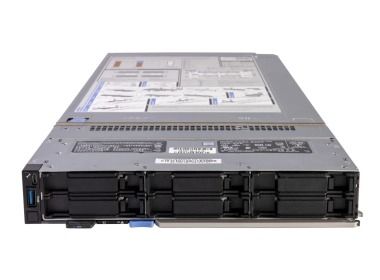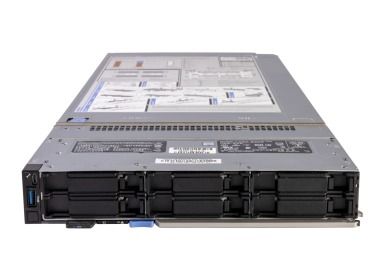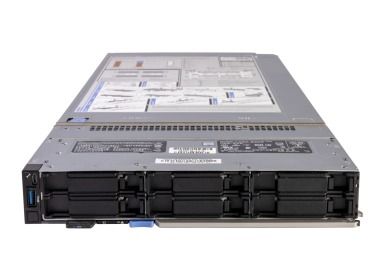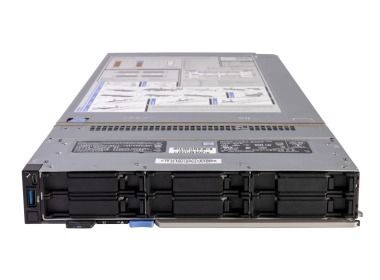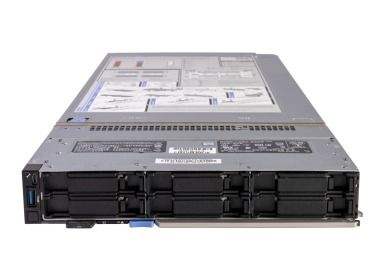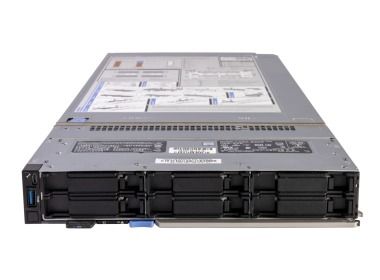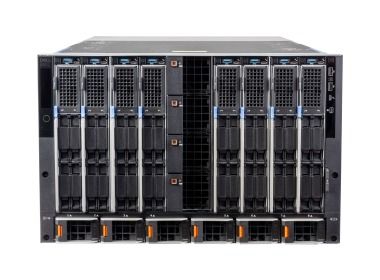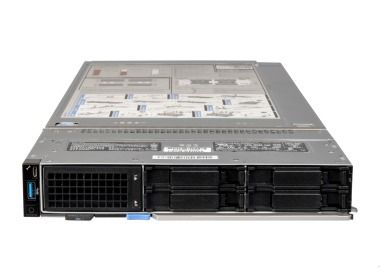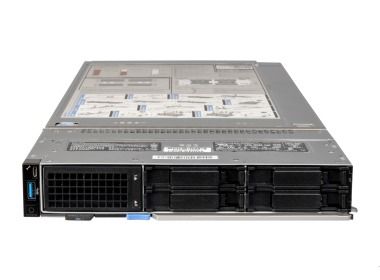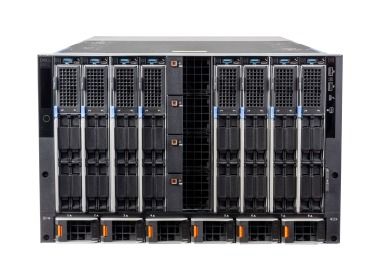- Server Dell PowerEdge MX740c 6x2.5" with 2xSilver 4114, 32GB, 2x 480GB SSD SATA 2.5", 2x25GbE SFP28This set contains: 1x Dell PowerEdge MX740c 6x2.5" server platform 2x Intel Xeon Silver 4114 10-core 2.2GHz 13.75MB 85W SR3GK processor 2x RAM 16GB 2400MH...Calculating delivery time...In stock 4Warranty 36 monthsPLN 4,750.00 PLN 3,861.79
- Server Dell PowerEdge MX740c 6x2.5" with 1x Bronze 3106, 16GB, 2x 480GB SSD SATA 2.5", 2x25GbE SFP28This set contains: 1x Dell PowerEdge MX740c 6x2.5" server platform 1x Intel Xeon Bronze 3106 8-core 1.7GHz 11MB 85W SR3GL processor 1x RAM 16GB 2133MHz DD...Calculating delivery time...In stock 5Warranty 36 monthsPLN 4,750.00 PLN 3,861.79
- Server Dell PowerEdge MX740c 6x2.5" with 2xGold 5120, 32GB, 2x 480GB SSD SATA 2.5", 2x25GbE SFP28This set contains: 1x Dell PowerEdge MX740c 6x2.5" server platform 2x Intel Xeon Gold 5120 14-core 2.2GHz 19.25MB 105W SR3GD processor 2x RAM 16GB 2400MHz...Calculating delivery time...In stock 4Warranty 36 monthsPLN 4,800.00 PLN 3,902.44
- Server Dell PowerEdge MX740c 6x2.5" with 1xSilver 4110, 32GB, 2x 480GB SSD SATA 2.5", 2x25GbE SFP28This set contains: 1x Dell PowerEdge MX740c 6x2.5" server platform 2x Intel Xeon Silver 4110 8-core 2.1GHz 11MB 85W SR3GH processor 2x RAM 16GB 2400MHz DD...Calculating delivery time...In stock 4Warranty 36 monthsPLN 4,800.00 PLN 3,902.44
- Server Dell PowerEdge MX740c 6x2.5" with 2xGold 6130, 32GB, 2x 480GB SSD SATA 2.5", 2x25GbE SFP28This set contains: 1x Dell PowerEdge MX740c 6x2.5" server platform 2x Intel Xeon Gold 6130 16-core 2.1GHz 22MB 125W SR3B9 processor 2x RAM 16GB DDR4 2666M...Calculating delivery time...In stock 4Warranty 36 monthsPLN 5,025.01 PLN 4,085.37
- Server Dell PowerEdge MX740c 6x2.5" with 2xGold 6144, 32GB, 2x 480GB SSD SATA 2.5", 2x25GbE SFP28This set contains: 1x Dell PowerEdge MX740c 6x2.5" server platform 2x Intel Xeon Gold 6144 8-core 3.5GHz 24.75MB 150W SR3TR processor 2x RAM 16GB DDR4 266...Calculating delivery time...In stock 1Warranty 36 monthsPLN 6,025.00 PLN 4,898.37
- Server Chassis Dell MX7000 with 9xFAN, 6xPSU, RailsThis set contains: 1x Dell PowerEdge MX7000 platform 6x Dell power supply 1x Rails kit 2x Dell EMC MX7000 management module...Calculating delivery time...In stock 4Warranty 36 monthsSpecial offer available until further notice.Special Price PLN 9,212.70 PLN 7,490.00 Regular Price PLN 15,000.00
- Server Dell PowerEdge MX750c 4x2.5" with 2x Silver 4314, 256GB RAM, 2x 960GB SSD SATA 2.5", 2x10GbE BASE-KR, iDRAC 9This set contains: 1x Dell PowerEdge MX750c 4x2.5" server platform 2x Intel Xeon Silver 4314 16-core 2.4GHz 24MB 135W SRKXL processor 16x RAM 16GB DDR4 26...Calculating delivery time...In stock 25Warranty 36 monthsSpecial offer available until further notice.Special Price PLN 14,501.70 PLN 11,790.00 Regular Price PLN 14,600.00
- Server Dell PowerEdge MX750c 4x2.5" with 2xSilver 4310, 256GB RAM, S150, 4x1.92TB SATA SSD, 2x10GbE SFP+, iDRAC9 EnterpriseThis set contains: 1x Dell PowerEdge MX750c 4x2.5" server platform 2x Intel Xeon Silver 4310 12-core 2.1GHz 18MB 120W SRKXN processor 8x RAM 32GB 3200MHz ...Calculating delivery time...In stock 5Warranty 36 monthsPLN 15,900.00 PLN 12,926.83
- Server Dell PowerEdge MX750c 4x2.5" with 2xGold 6330, 192GB RAM, S150, 4x960GB SSD NVMe, iDRAC9 EnterpriseThis set contains: 1x Dell PowerEdge MX750c 4x2.5" server platform 2x Intel Xeon Gold 6330 28-core 2.0GHz 42MB 205W SRKHM processor 12x RAM 16GB DDR4 2666...Calculating delivery time...In stock 6Warranty 36 monthsPLN 19,300.00 PLN 15,691.06
- Server Dell PowerEdge MX750c 4x2.5" with 2xPlatinum 8380, 384GB RAM, S150, 4x3.84TB SSD NVMe, iDRAC9 EnterpriseThis set contains: 1x Dell PowerEdge MX750c 4x2.5" server platform 2x Processor Intel Xeon Platinum 8380 40-core 2.3GHz 60MB 270W SRKHR 12x RAM 32GB 2666M...Calculating delivery time...In stock 1Warranty 36 monthsPLN 65,100.00 PLN 52,926.83
- Server Dell PowerEdge MX7000 with 8x Server Dell PowerEdge MX750c 4x2.5" (2xSilver 4310, 256GB RAM, S150, 4x1.92TB SATA SSD, 2x10GbE SFP+, iDRAC9 Enterprise)This set contains: 1x Dell PowerEdge MX7000 platform with 9xFAN, 6xPSU, rails 8x Server Dell PowerEdge MX750c 4x2.5" with 2xSilver 4310, 256GB RAM, S150, ...Calculating delivery time...In stock 2Warranty 36 monthsPLN 141,999.99 PLN 115,447.15
- Server Dell PowerEdge MX7000 with 8x Server Dell MX750c 4x2.5" (2xGold 6330, 192GB RAM, S150, 4x960GB SSD NVMe, iDRAC9 Enterprise)This set contains: 1x Dell PowerEdge MX7000 platform with 9xFAN, 6xPSU, rails 8x Server Dell PowerEdge MX750c 4x2.5" with 2xGold 6330, 192GB RAM, S150, 4x...Calculating delivery time...In stock 4Warranty 36 monthsPLN 168,800.00 PLN 137,235.77
- Server Dell PowerEdge MX7000 with 8x Server Dell PowerEdge MX750c 4x2.5" (2xPlatinum 8380, 384GB RAM, S150, 4x3.84TB SSD NVMe, iDRAC9 Enterprise)This set contains: 1x Dell PowerEdge MX7000 platform with 9xFAN, 6xPSU, rails 8x Server Dell PowerEdge MX750c 4x2.5" with 2xPlatinum 8380, 384GB RAM, S150...Calculating delivery time...In stock 2Warranty 36 monthsPLN 535,599.99 PLN 435,447.15
Tired of infrastructure that can't keep up with your company's growth? Dell PowerEdge MX7000 is a platform that grows with your needs. Instead of replacing hardware every year, you can simply expand it – without downtime, without rebuilding the environment, without stress. The modular kinetic architecture allows you to flexibly manage compute power, memory, and networking – exactly as you need it.
MX7000 – A Scalable Foundation That Doesn't Lock You Into a Single Configuration
Within a single enclosure, you can combine servers, storage, and networking, and then manage them centrally – thanks to OpenManage Enterprise Modular Edition. It's not just convenient, but also offers real savings in time and administrative costs. Want to add another blade? You don't need to shut anything down. The system keeps running, and you expand resources exactly when you actually need them.
Choices include the MX740c – with two Xeon Scalable processors, an impressive 24 RAM slots (up to 3 TB), and six drive bays. An ideal solution for virtualization, parallel processing, or hybrid environments. For larger deployments, it's worth looking at the MX840c – up to four CPUs, 6 TB of RAM, and up to eighteen drives. This is a configuration that can easily handle large databases, analytics, HPC clusters, or extensive ERP systems.
Flexibility That Makes a Difference – From Test Environments to Data Centers
The MX7000 excels where traditional servers start to fall short. Thanks to its modular architecture, you can run multiple roles within a single enclosure: some servers act as virtualization nodes, others as data storage or application backends. You no longer have to choose between performance and space savings – MX7000 delivers both.
Whether you're building a new IT environment or modernizing an existing one – this platform gives you an advantage. Integrated management, expansion without interrupting operations, compatibility with the latest technologies, and room for growth. All this translates into greater operational efficiency, lower costs, and infrastructure that finally works as it should – without excess, but with headroom.








